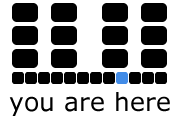Contingency
by Jentery, Curtis, Matthew & Jamie
We have described “Standards in the Making” (SITM) as a process, as a method for critical inquiry and production. Across these two thrusts of SITM, the notion of contingency highlights the importance of context, situation, and opportunities for emergent standards. Contingency marks the necessity of reading and producing metadata as situational representations of “data.” Data is contingent upon metadata, and further, that metadata itself is multiply contingent: on the protocol, cultural formations, platform, archive, collaboration, and rhetorical situation, among others. In addition to inquiry as to these multiple contingencies, we have recognized that a SITM approach also is the practice of creating metadata that enables explicit connections to these contingencies: metadata as a contingent, situated practice.
Curtis takes up the former concern, of SITM as inquiry, in his discussion of the folksonomies of the “Negro Boy” (2008) photo in the Flickr Commons. Here, he demonstrates how a SITM approach enables the visualization of discursive struggle around contingent cultural formations.
“As a historical artifact, the photo itself is problematically situated at the intersection of at least two different (if not contradictory) historical knowledge projects set to define the nature of black identity. … 'Tagging,' in such instances such as these does not so much “describe” digital artifacts as much as it appropriates them and composes them in the name of more general logics of history and identity.”
The cultural legibility of the photo works as a kind of boundary object, where multiple knowledge communities differently appropriate the artifact towards certain logics. Curtis further elaborates this move of SITM inquiry, to recognize the ways in which these contingent logics function as a generative constraint, where the production of metadata is partially limited by the “terminological complexities and representational logics that make up our contemporary social formation.”
The latter concern, of SITM as creative practice, is taken up more directly by Jamie, Matt, and Jentery. The work of metadata is about making data contingent. Jamie writes, “the application of metadata to an informatic object is an attempt to situate it — to categorize it in terms of an accepted or emerging schema — within a larger system.” In the context of the Flickr Commons, Jentery notes that tags, as metadata, work to assemble photos across a collection, that “even if it is a tag that simply describes what can be seen in the image, it also functions to aggregate a variety of images around an array of cultural formations, including race and ethnicity…, geography…, labor…, and gender.” Similarly, Matt argues that SITM as a practice is about “making data situational.” For him, the contingency of metadata is produced (and productive). Metadata that is contingent, he continues, is able “to invite cross-readings; to underscore dissension; to decouple artifact from single, unified author; to make the artifact multiply; and to make these move.”
SITM involves being attentive to contingency. While we may agree that a SITM approach enables one to read the contingencies contained within folksonomic systems like the Library of Congress Flickr Commons, the question of how to provide protocols and platforms to render contingency-making an explicit practice remains a fruitfully open one.
